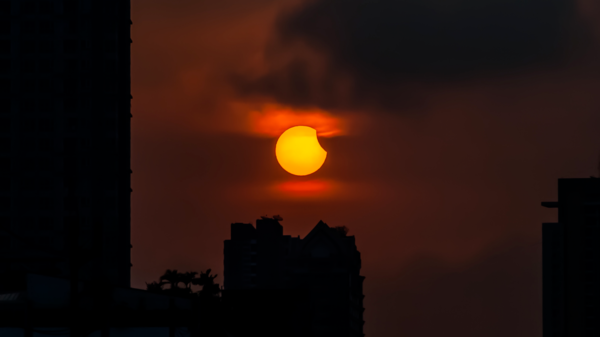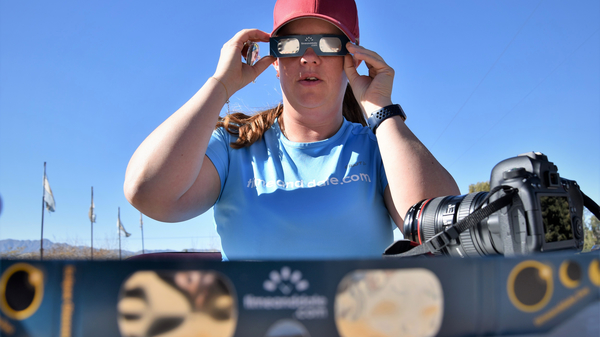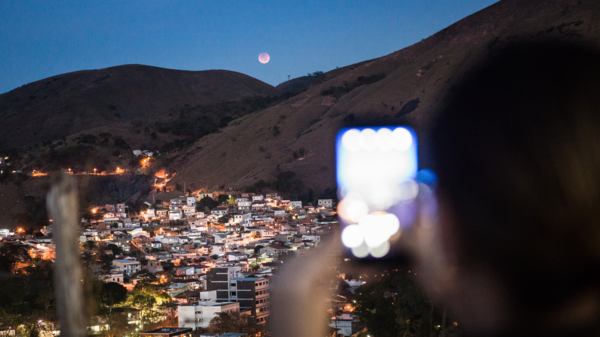10 things about the October–November eclipse season
Eclipses come within periods known as eclipse seasons. The October–November 2022 season features a partial solar eclipse and a total lunar eclipse.

The Moon will bite the Sun on October 25, producing a partial solar eclipse. Two weeks later, on November 7–8, Earth’s shadow will cover the Moon, resulting in a total lunar eclipse. You can watch both events LIVE on timeanddate.
©iStockphoto.com/apidechphoto
1. It features a pair of eclipses: one solar, one lunar
The October–November 2022 eclipse season features the following events:
- A partial solar eclipse across parts of Europe and Asia on October 25
- A total lunar eclipse across North America, Australia, and parts of Asia and South America on November 7–8
What is an eclipse season? Roughly twice a year, there are two windows—each about 34 days long—when at least one solar and one lunar eclipse must occur. These windows are known as eclipse seasons.
2. It ends a run of big lunar eclipses...
The lunar eclipse on November 7–8 is the third total lunar eclipse in 18 months, but the final one until 2025.
This 18-month period almost included four total lunar eclipses. But the second lunar eclipse of 2021, on November 18–19, just failed to reach totality. (It was a very deep partial eclipse, with 99.1% of the Moon’s surface covered by Earth’s umbral shadow.)
3. ...and sets the stage for a golden period of solar eclipses
Likewise, the solar eclipse on October 25 is the final partial solar eclipse until 2025. The next three eclipses of the Sun will be high-profile affairs.
- April 2023: a total eclipse across Australia’s North West Cape, East Timor, and Indonesia
- October 2023: an annular eclipse across the USA, Mexico, and Central and South America
- April 2024: a total eclipse across Mexico, the USA, and Canada

Anne Buckle, one of the hosts of timeanddate’s LIVE streams, demonstrates the way to watch a solar eclipse.
©Anibal Heredia
4. Eye safety is important
Be serious about eye safety: never look at the Sun without proper eye protection.
At timeanddate we’re helping to spread the safety message by giving away thousands of eclipse glasses within our local community. (We’re based in Stavanger, Norway, which gets a 33% partial solar eclipse on October 25.)
We’re also supporting our wonderful friends at Astronomers Without Borders: they run an amazing campaign where eclipse glasses are recycled and sent to people around the world who otherwise have no safe way to watch an eclipse.
5. We’re broadcasting the eclipse season with our partners...
Astronomy is a collaborative exercise. We’re doing a LIVE broadcast of both the October 25 solar eclipse and the November 7–8 lunar eclipse, and this is only possible with the support of our stellar partners around the globe.
From west to east they are: Subaru Telescope (Hawaii), San Diego Astronomy Association (California), Amateur Astronomers Association (New York), Go Stargazing (UK), University of Siena (Italy), National Institute for Astrophysics (Italy), Vilnius University (Lithuania), ISTEK Belde Schools Science Center (Turkey), International Astronomical Center (United Arab Emirates), and Perth Observatory (Australia).
6. ...and hitting the road ourselves
For our LIVE broadcasts, our mobile observatory team—led by our intrepid CEO Steffen Thorsen—will again be heading into the wild.
For the solar eclipse our team will be travelling up into the Arctic, somewhere in northern Norway or Finland. They will monitor the weather forecasts closely and decide on a final destination at the last possible minute.
As soon as they’re back from the Arctic, they’ll be off again: this time to the deserts of New Mexico for the lunar eclipse.
We’re collaborating with Peggy Bohlin and her colleagues at Roswell Astronomy Club, who are based in the world-famous city of the same name. We’ll be teaming up with the club again for the big annular eclipse next year, when Roswell gets almost five minutes’ worth of the ring of fire.

timeanddate CEO Steffen Thorsen will once again be venturing forth with our mobile observatory team.
©timeanddate.com
7. The solar eclipse will cover billions of people
For the solar eclipse, according to our data, around 3.2 billion people will get covered by some part of the Moon’s outer shadow as it strikes the Earth. This is about two-fifths of the world’s population. (Our population data is based on figures provided by the Center for International Earth Science Information Network at Columbia University.)
Almost half of these people will be in India, which is set to overtake China next year as the world’s most populous country.
8. We’re crossing our fingers for clear skies
One of the challenges for the solar eclipse will be the weather. According to our cloud tool—based on historical satellite data over a 20-year period—many locations across Europe and Central Asia have somewhere between a 60% and 90% chance of being covered by clouds.
But it is not all doom and gloom. Many parts of the Middle East and South Asia have a less than 10% chance of cloud cover.
Check the latest weather forecasts for your location

The total lunar eclipse on on November 7–8 will turn the Moon red—the famous ‘blood Moon’ effect.
©iStockphoto.com/Igor Alecsander
9. This is a once-in-four-centuries lunar eclipse
This is the second eclipse season of 2022. The first, in May–June, likewise featured a partial solar eclipse and a total lunar eclipse.
For the two lunar eclipses of 2022, the length of totality is almost identical: 1 hour 24 minutes 50 seconds for the May 15–16 event, and 1 hour 24 minutes 54 seconds for November 7–8.
According to our data, this is the most balanced pair of total lunar eclipses within the same calendar year in over four centuries. (In the 430-year period from 1661 to 2091, there is no other year that contains two total lunar eclipses of such equal length.)
10. Watch out for a totally eclipsed moonrise in Australia
Weather permitting, one of the highlights of our lunar eclipse LIVE stream will be watching a totally eclipsed Moon rising over Perth in Western Australia. These images will come from our longtime streaming partner Matt Woods at Perth Observatory.
The Moon appears much fainter when it is completely covered by Earth’s shadow during totality. An interesting question for our live stream audience is: how visible will the dim Full Moon appear through the telescope as it rises above the twilit horizon?
We’ll be teaming up again with Matt in April next year to stream the total solar eclipse from Exmouth, a small town about 1200 km (750 miles) north of Perth.